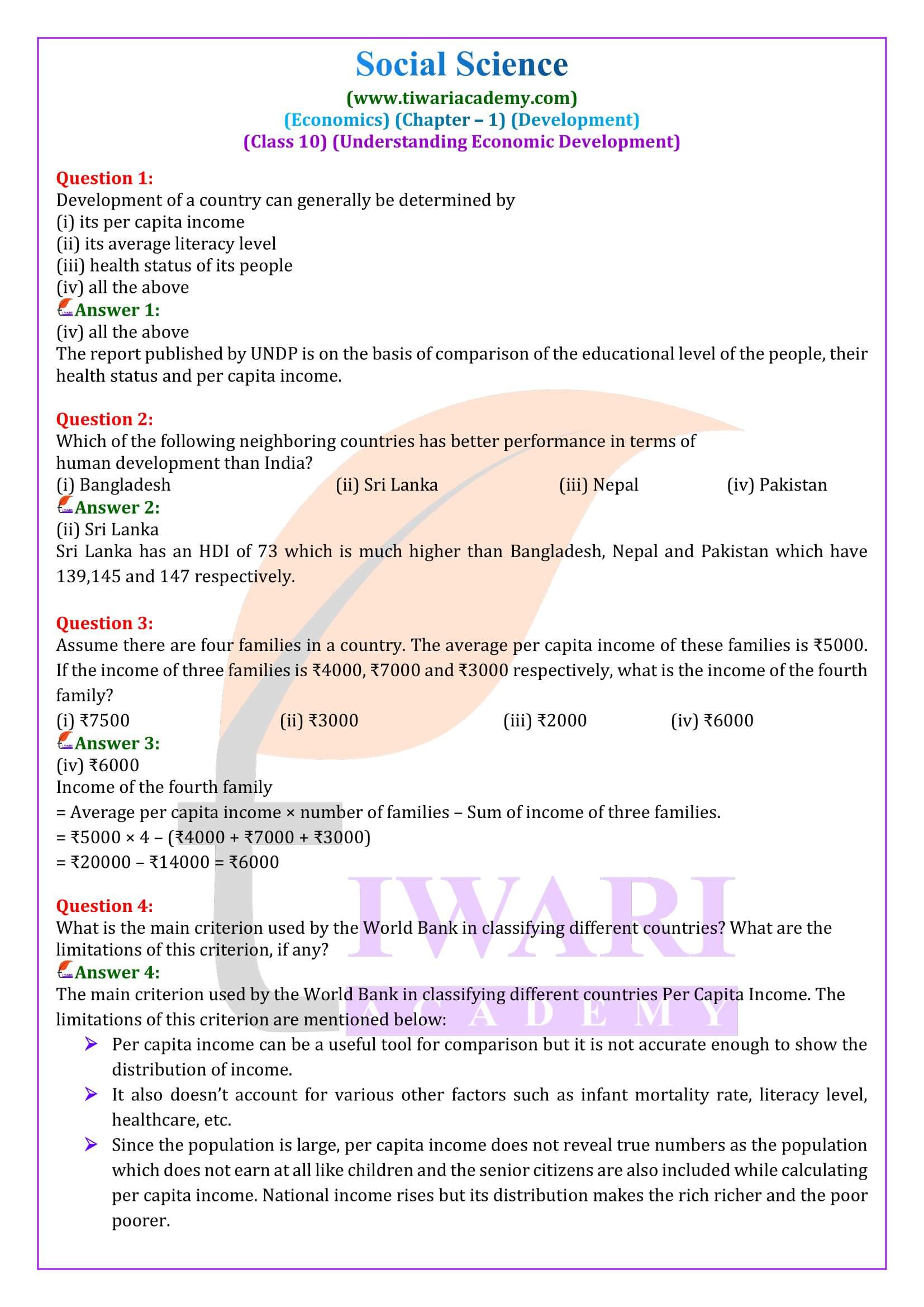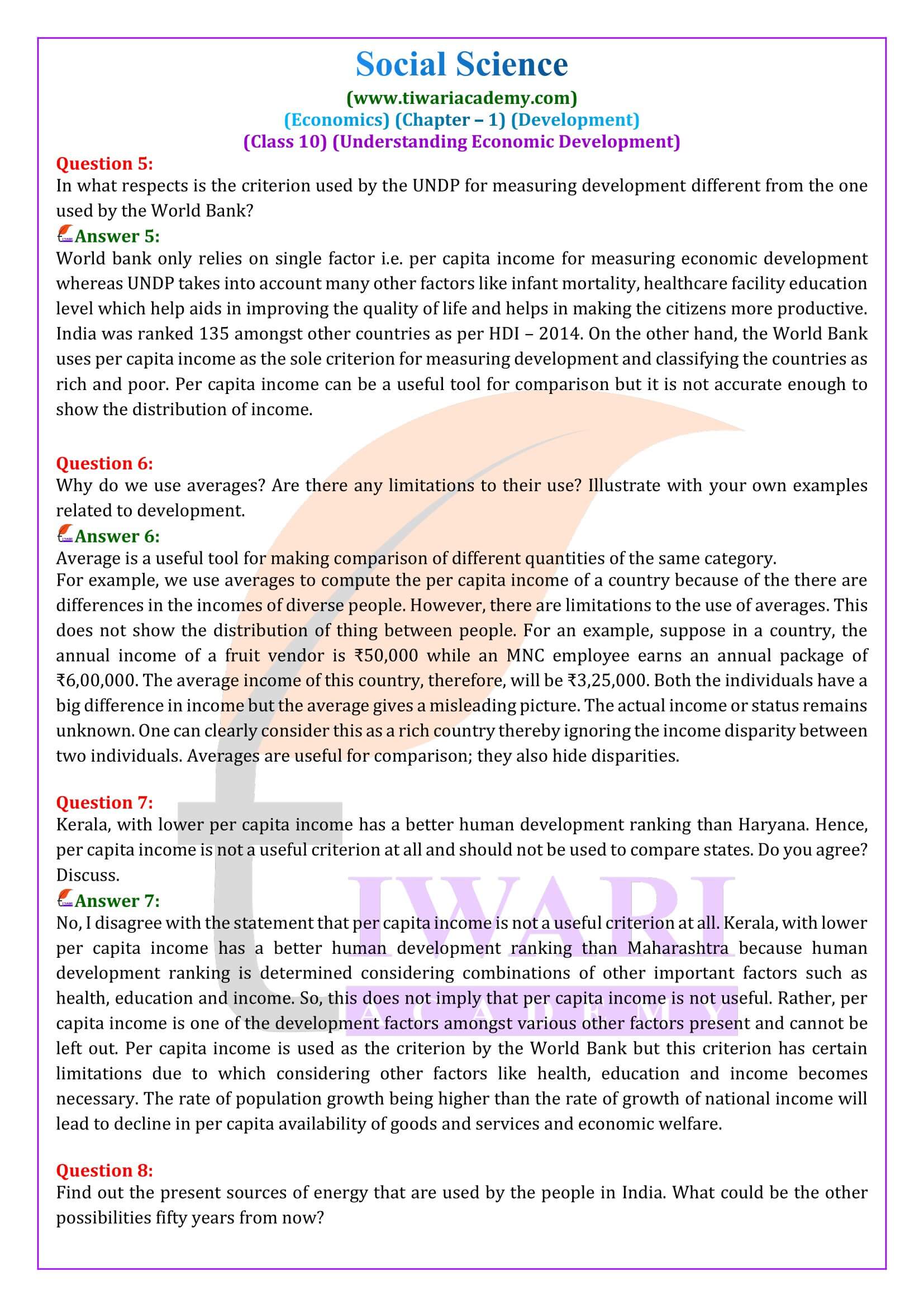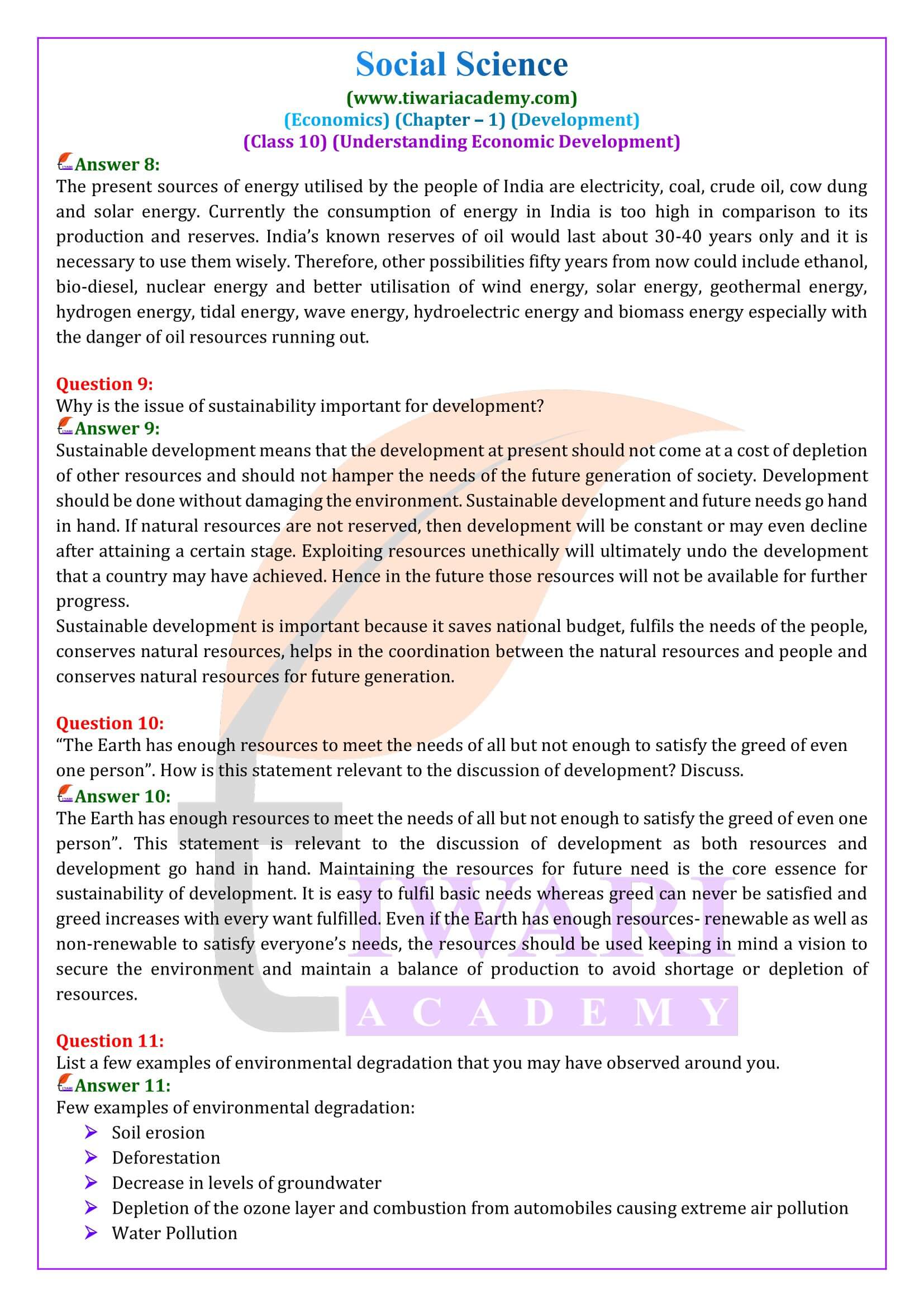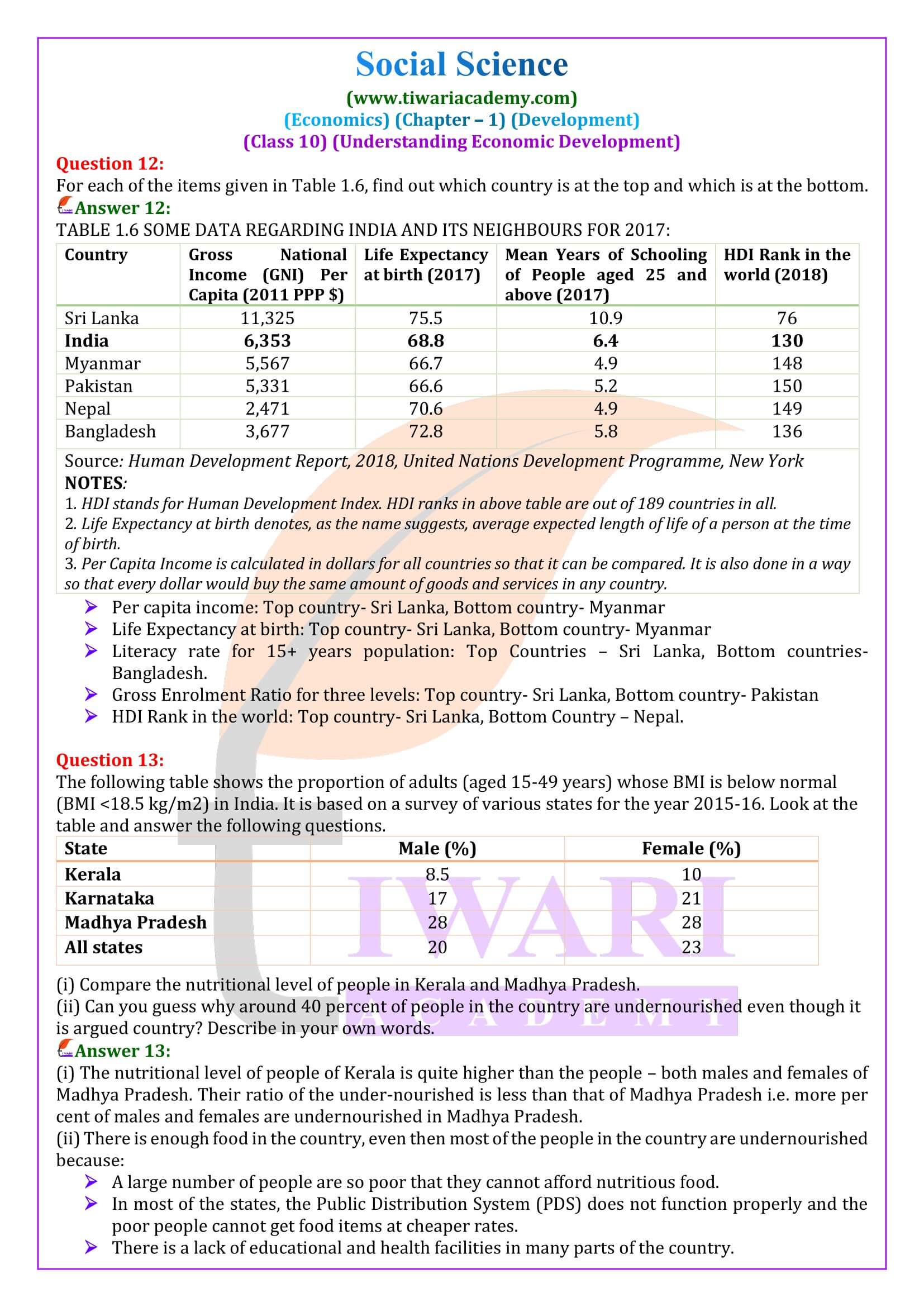NCERT Solutions for Class 10 Economics Chapter 1 Development in Hindi and English Medium updated for new academic session 2025-26 for all the students who are using books based on current NCERT Books and latest CBSE Syllabus. Visit to Discussion Forum of Tiwari Academy and ask your doubts and get the answers from subject experts and other users.
NCERT Solutions for Class 10 Economics Chapter 1
| Class: | 10 |
| Subject: | Social Science – Economics |
| Chapter 1: | Development |
| Academic Session: | 2025-26 |
NCERT Solutions for Class 10 S.St. Economics Chapter 1
NCERT Solutions for Class 10 Social Science Economics Chapter 1 Development in PDF form is given below to free download. Visit to Discussion forum to share your knowledge and ask doubts related for NIOS or CBSE or UP Board. Download Offline Apps and latest NCERT Books for offline use.
Exatra Questions Class 10 Economics Chapter 1
What do you mean by National development?
National development refers to the ability of a nation to improve the lives of its citizens. Measures of improvement may be material, such as availability of healthcare etc.
What is Sustainable Development?
Sustainable Development is development that meets the needs of the present without compromising the ability of future generations to meet their own needs.
What does HDI refer?
HDI refers to Human Development Index. It is a composite statistic of life expectancy, education and per capita income indicators, which are used to rank countries in four tires of human development.
How is BMI of a person calculated?
BMI- can be calculated by taping the weight of a person (in kg) & height (in metres) then divide the weight by the square of the height of a person. If the result is less than 18.5 then person in under nourished & if more than 25, then person is overweight.
What is meant by Infant Mortality Rate?
Infant Mortality Rate can be defined as total number of children that die before the age of one year out of 1000 live children born in that particular year.
What is Literacy Rate?
Literacy rate can be defined as proportion of literate population in the age group of 7 years & above.
What is Net Attendance Ratio?
Net attendance Ratio can be defied as the total number of children of 6-10 years’ age group attending school out of total no. of children in the same age group.
About Class 10 Economics Chapter 1 Development.
Development is generally defined as growth. Some of the important goals are – seeking more income, equal treatment, freedom, security, and respect from others. Different people have different development goals. What may be development for one May not be for the other. It may be destructive for the other. One would consider earning more income, being a common factor among people. With this income, they buy services and goods for their daily needs.
One Mark Questions with Answers
1. What is Life Expectancy at birth?
2. What is GDP?
3. What are Public facilities?
4. Which organization publishes the Human Development Report?
5. What are the Non-renewable resources?
Answers of 1 Mark Questions
1. It is the average expected length of a person’s life at the time of birth.
2. It stands for Gross Domestic Product. It meant for monetary measure of the market value of all final goods and services produced in a given period of time.
3. Public facilities are those which are provided by the government to satisfy the collective needs of the people. Such as — Hospital, School and so on.
4. United Nations Development Programme (UNDP).
5. These resources will get exhausted after some time and are not regenerated by the nature. For example, crude oil and so on.
Multiple Choice Questions – MCQ
1. Which of the following is most likely to be a development goal for landless rural labourers:
(a) Highest support prices
(b) High literacy rate
(c) Raised Wages
(d) Settle the children abroad
2. Life expectancy at Birth means:
(a) Average expected length of life of a person at the time of birth.
(b) Average expected length of life of a person at time of death.
(c) Average expected length of a child at time of birth.
(d) None of above
Q.3 Which one of the following countries has the largest size of illiterate population in the age group of 15 in the world.
(a) India
(b) Myanmar
(c) Srilanka
(d) Bangladesh
Q.4. Kerala has low infant mortality rate what in the reason for the same?
(a) It has adequate provision of basic health & educational facilities.
(b) It has highest per capita income
(c) It has natural resources
(d) The government of Kerala is very efficient.
Q.5. Which state among the following has lowest literacy rate?
(a) Punjab
(b) Bihar
(c) Kerala
(d) Tamil Nadu
Answers of MCQ
1. (c)
2. (a)
3. (d)
4. (a)
5 (b)
Download NCERT Books and Offline Apps 2025-26 based on new CBSE Syllabus. Ask your doubts related to NIOS or CBSE Board and share your knowledge with your friends and other users through Discussion Forum.
Important Questions on Class 10 Economics Chapter 1
What is the main criterion used by the World Bank in classifying different countries? What are the limitations of this criterion, if any?
The main criterion used by the World Bank in classifying different countries Per Capita Income. The limitations of this criterion are mentioned below: a). Per capita income can be a useful tool for comparison but it is not accurate enough to show the distribution of income. b). It also doesn’t account for various other factors such as infant mortality rate, literacy level, healthcare, etc. c). Since the population is large, per capita income does not reveal true numbers as the population which does not earn at all like children and the senior citizens are also included while calculating per capita income. National income rises but its distribution makes the rich richer and the poor poorer.
In what respects is the criterion used by the UNDP for measuring development different from the one used by the World Bank?
World bank only relies on single factor i.e. per capita income for measuring economic development whereas UNDP takes into account many other factors like infant mortality, healthcare facility education level which help aids in improving the quality of life and helps in making the citizens more productive. India was ranked 135 amongst other countries as per HDI – 2014. On the other hand, the World Bank uses per capita income as the sole criterion for measuring development and classifying the countries as rich and poor. Per capita income can be a useful tool for comparison but it is not accurate enough to show the distribution of income.
Average is a useful tool for making comparison of different quantities of the same category. For example, we use averages to compute the per capita income of a country because of the there are differences in the incomes of diverse people. However, there are limitations to the use of averages. This does not show the distribution of thing between people. For an example, suppose in a country, the annual income of a fruit vendor is ₹50,000 while an MNC employee earns an annual package of ₹6,00,000. The average income of this country, therefore, will be ₹3,25,000. Both the individuals have a big difference in income but the average gives a misleading picture. The actual income or status remains unknown. One can clearly consider this as a rich country thereby ignoring the income disparity between two individuals. Averages are useful for comparison; they also hide disparities.
Kerala, with lower per capita income has a better human development ranking than Haryana. Hence, per capita income is not a useful criterion at all and should not be used to compare states. Do you agree? Discuss.
No, I disagree with the statement that per capita income is not a useful criterion at all. Kerala, with lower per capita income has a better human development ranking than Maharashtra because human development ranking is determined considering combinations of other important factors such as health, education and income. So, this does not imply that per capita income is not useful. Rather, per capita income is one of the development factors amongst various other factors present and cannot be left out. Per capita income is used as the criterion by the World Bank but this criterion has certain limitations due to which considering other factors like health, education and income becomes necessary. The rate of population growth being higher than the rate of growth of national income will lead to decline in per capita availability of goods and services and economic welfare.
Find out the present sources of energy that are used by the people in India. What could be the other possibilities fifty years from now?
The present sources of energy utilised by the people of India are electricity, coal, crude oil, cow dung and solar energy. Currently the consumption of energy in India is too high in comparison to its production and reserves. India’s known reserves of oil would last about 30-40 years only and it is necessary to use them wisely. Therefore, other possibilities fifty years from now could include ethanol, bio-diesel, nuclear energy and better utilisation of wind energy, solar energy, geothermal energy, hydrogen energy, tidal energy, wave energy, hydroelectric energy and biomass energy especially with the danger of oil resources running out.
Why is the issue of sustainability important for development?
Sustainable development means that the development at present should not come at a cost of depletion of other resources and should not hamper the needs of the future generation of society. Development should be done without damaging the environment. Sustainable development and future needs go hand in hand. If natural resources are not reserved, then development will be constant or may even decline after attaining a certain stage. Exploiting resources unethically will ultimately undo the development that a country may have achieved. Hence in the future those resources will not be available for further progress. Sustainable development is important because it saves national budget, fulfils the needs of the people, conserves natural resources, helps in the coordination between the natural resources and people and conserves natural resources for future generation.







